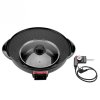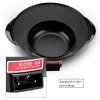- Oct 9, 2002
- 28,298
- 1,235
- 136
The sister of my boss / landlord sent this screenshot:

She asked me to find a hot pot like the one in the picture. Though the picture makes it look HUGE, I believe it's actually much smaller. I found some models online with a similar style, but they are all 220-volt.


Since the temperature control is on the detachable 220-volt cord thing, I assume the electrical connections on the hot pot lead directly to the heating elements. Would it be possible (and safe) to use a similar cord from a 120-volt griddle or something?
This is the product listing I got those pictures from:
https://www.aliexpress.com/item/32984646818.html
She asked me to find a hot pot like the one in the picture. Though the picture makes it look HUGE, I believe it's actually much smaller. I found some models online with a similar style, but they are all 220-volt.


Since the temperature control is on the detachable 220-volt cord thing, I assume the electrical connections on the hot pot lead directly to the heating elements. Would it be possible (and safe) to use a similar cord from a 120-volt griddle or something?
This is the product listing I got those pictures from:
https://www.aliexpress.com/item/32984646818.html



